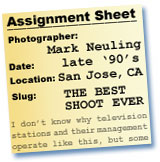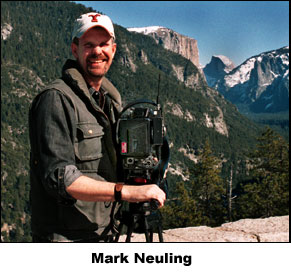THE
BEST SHOOT EVER
By Mark Neuling
Photojournalist for TechTV San Francisco, California
I
don’t know why television stations and their management
operate like this, but sometimes they do. Always on the lookout
for “revenue streams,” the small independent television
station that I use to work for had had a very modest success syndicating
programming to cable outlets. The emphasis here is on “modest” succes.
For some reason the station looked outside and beyond it’s
own staff to crew and shoot these ventures. We had five or
six very competent photographers, all with a great deal of news
experience
who were always bypassed for these assignments. Management
felt more comfortable hiring outside freelancers. The gallows humor
amongst the shooters was that management felt that if we
were any
good, we’d all be working elsewhere. But quite honestly
we didn’t want to do these shoots, too much scrutiny
by upper management.
In the defense of our photography staff most of our photographers
weren’t equipped to do more than a basic news shoot. What
ever gear the photographer and reporter could carry from the car
was it. No fancy lighting, no dolly’s, no jibs. Just the
camera, tripod and “maybe” a light. Most of our shooters
didn’t have more than two battered lights to begin with,
most had never done anything more than a basic lighting set up.
Daily news, under a deadline, doesn’t require much. And quite
frankly, unless the video is blue, most managers don’t
care.
But one day word came of an important shoot. We had an interview
scheduled with the actress Shelley Fabares. Her mother had
passed away from Alzheimer’s Disease and she was going
to do an interview with us about her family’s struggle
with the illness. The normal freelance crew was unavailable,
they
were
off in Europe
somewhere, tough gig. The shoot would have to be done by
one of the in-house crews. Since my partner Paul Felt and
I were
the Electronic
Field Production unit the shoot would be our responsibility.
We had a half-a-dozen lights, flags, reflectors, audio mixer
and even a monitor at our disposal. Hey if you can make the
daughter of some car salesman look good, we shouldn’t
have any problem with an attractive Hollywood actress. As
always, management had
their panties all in a knot over this shoot, and as always,
the crew was pretty blasé about it. Just another talking
head.
Of course Shelley Fabares is not just another talking head.
Her career has spanned four decades in the entertainment
industry and includes not only acting but singing as well.
Beginning
in
1958
she co-starred on the “Donna Reed Show” playing
the bewitching Mary Stone. While starring on this series
she had a
number one hit song with the tune “Johnny Angel.” In
the 1960’s she co-starred in three Elvis Presley movies.
During the 1990’s she played TV news anchor Christine
Armstrong Fox on the show “Coach.” And in real
life she is married to actor Mike Farrell of “MASH” fame.
By anyone’s
standards this is a pretty good Hollywood resume.
My little station, as most little stations are, was pretty
tight with the purse strings. But occasionally, for big events
such
as this, they would break into the piggy bank and spend like
sailors
on shore-leave. They rented a suite at the Fairmont Hotel
in San Jose for us to do the shoot at. Hired a limousine
to bring
Ms.
Fabares from the airport, and they even brought in a makeup
artist. Oh this was the big time.
And then the day before the shoot our chief engineer dropped
by my cubicle with a brand new camera. Out of the blue, no
word or
rumor of it, a BRAND NEW CAMERA. What were they thinking.
Sure cameras are only tools, but in most shops you are assigned
a camera and it’s yours, sometimes for years. The life
expectancy of a broadcast camera is about five years, but
in many shops they
are used for many years beyond that. Your camera becomes
an extension of yourself. You learn your camera’s quirks,
its likes and dislikes, it’s like being married. The
initial shoot with a new camera is like going on a first
date.
In the old days cameras were simple. Turn it on. Select a
filter and white balance. Modern cameras have page after
page of menus,
set up cards and manuals that can run close to a hundred
pages, which when translated from the Japanese aren’t
always clear to understand. You have to date one these cameras
for a long time
before you understand it and can really utilize all the bells
and whistles. Of course on most days we pretty much still
just hit
the power switch, select a filter and white balance. Some
things haven’t changed much over the years.
The day of the shoot dawned. There must have been five or
six people from the station involved with the shoot. The
programming
director
(who never went on shoots) was the bull-goose-loony in charge
of this project. Her job was to handle the flowers that would
be in
the background of the shot. Yes dear reader those great looking
flower arrangements in television shots don’t happen
by accident. She must have cut the stems of the flowers three
times
before the
length was just right. The make up artist did the make-up
for both our talent and Ms. Fabares. Paul and I kept the
lighting
simple,
but elegant; a soft key light with some bounce off a reflector,
a back light, done. We even had time to tweak the lighting
for the reversal shots of our talent. Only a Hollywood actress
would
sit patiently while a crew re-lights a scene for a reversal.
Usually in these tales of mine you expect some disaster to
happen about now, but on this day everything went according
to plan.
I managed to find the on-switch to the camera without any
difficulty. Every one was awe-struck by how warm and sharp
the new camera
looked.
Our set in the hotel looked great. Ms. Fabares, as most actresses
are, was a consummate professional. She thanked everyone
by name and was very complimentary on the lighting job. We
wrapped the
shoot and then the general manager of the station surprised
us all with lunch; and yes even the lowly camera grunts were
invited.
We made our way to one of San Jose’s swank watering holes
a block away and sat down for lunch. The conversation eventually
steered it’s way to the “Donna Reed Show.” For
the record Shelley Fabares is an outstanding story teller. She
shared tales about the show and Donna Reed herself, it was like
our own private look into a small piece of television history.
Now camera grunts are usually expected to be seen and not heard,
but I was curious about how the song “Johnny Angel” came
to be, so I asked her.
She seemed to brighten, a shy Mona Lisa smile crossed her
face. In the early 60’s there was a lot of cross-over by television
actors/actresses into pop-music. The creator of the “Donna
Reed Show,” who happened to be Donna Reed’s husband,
approached Ms. Fabares one day and asked her if she’d like
to record a song. “Oh, but I’m not a singer,” Shelley
said. “You like working on the show don’t you?” he
asked her. “ Yes I do,” came the reply. “Then
you’ll do a song,” he told her.
And the song turned out to be “Johnny Angel.” It stayed
at number one on the Billboard Charts for two weeks, only to be
knocked out of the top slot by some guy named Elvis Presley. Shelley
told us that she went on to record five more albums and eleven
more singles; each selling progressively less than the one before.
Proof and vindication that she wasn’t a singer after
all.
So why was this shoot so special? I can’t really say to answer
my own question. There certainly was no great photojournalism
shot that day. Heck it was just a couple of talking heads, not
so unlike
the thousands I’ve shot before or since. I didn’t
even like the way the story turned out; too long and poorly
paced. It’s
neat to actually get to hang out with a celebrity, discovering
the real person inside, as opposed to jumping through the
protective hoops of some public relations minion. We certainly
had a good
time listening to Shelley’s stories, and the lunch
tab was paid for by the station. It’s just that sometime
all the elements come together. We did more than just our
job that day.
Some little spark of magic was ignited and the memory of
the shoot got burned into our consciousness. It’s these
times when we remember that this job can not only be fun,
but that it’s
one of the greatest jobs in the world.
Mark
Neuling
© Mark Neuling 2004
The opinions expressed are solely those of the author.
Email info: markneuling@techtvcorp.com
TechTV is the world’s leading cable and satellite television
channel covering technology news, information, and entertainment from
a consumer, industry, and market perspective 24 hours a day. Available
in more than 75 million households across 70 countries, TechTV is also
the world’s largest producer and distributor of programming
about technology.
Copyright TechTV 2003 TechTV Inc. All rights reserved.

